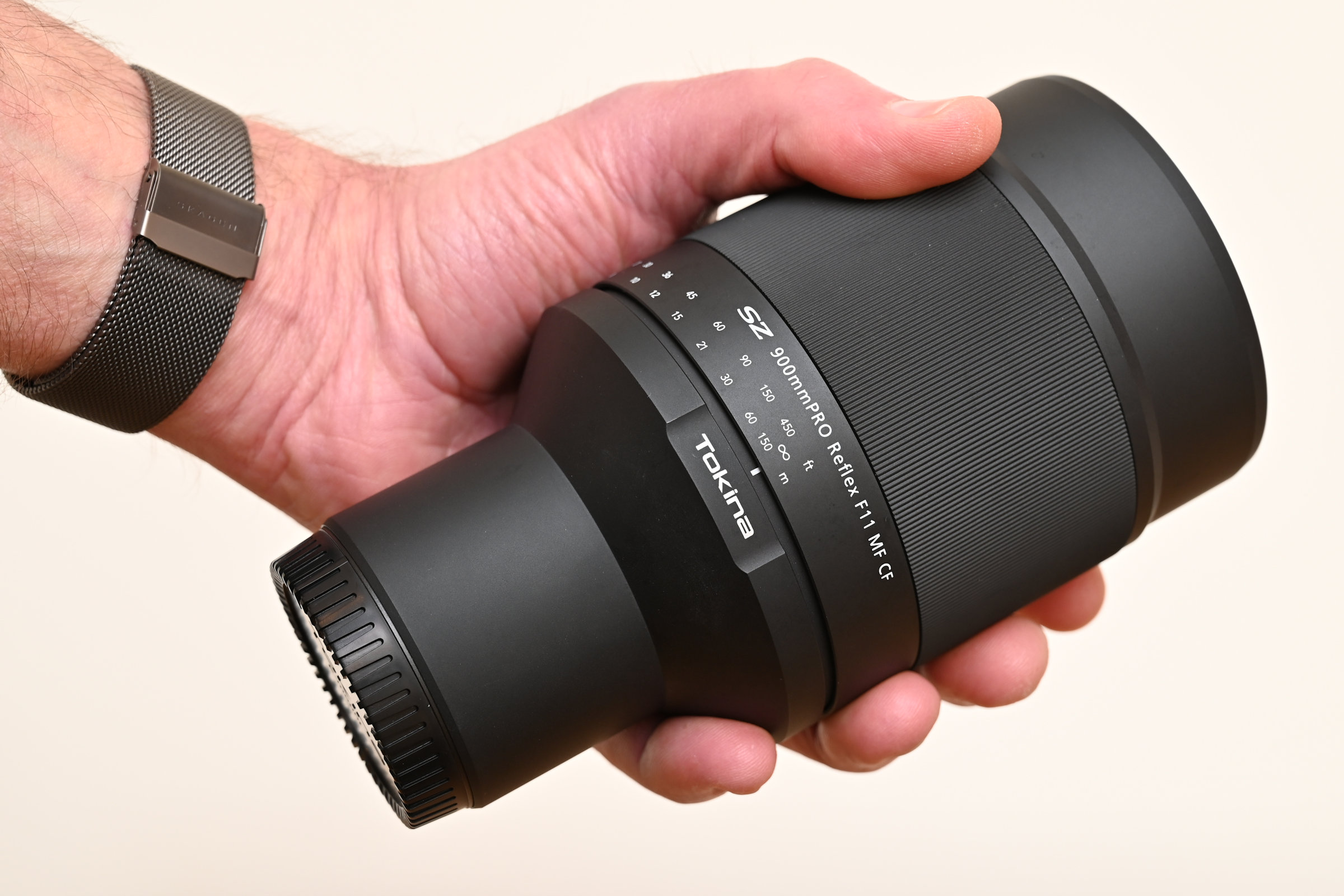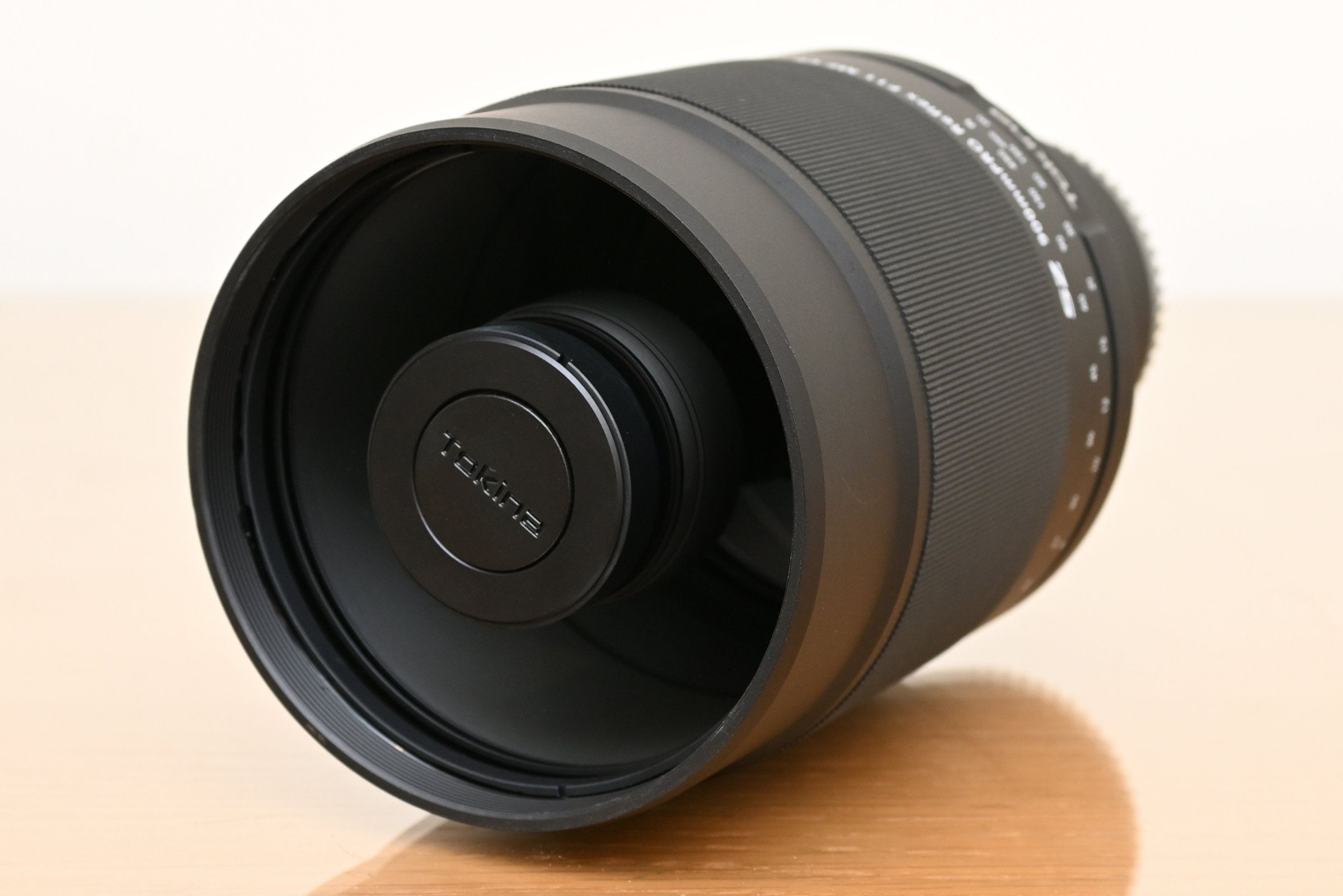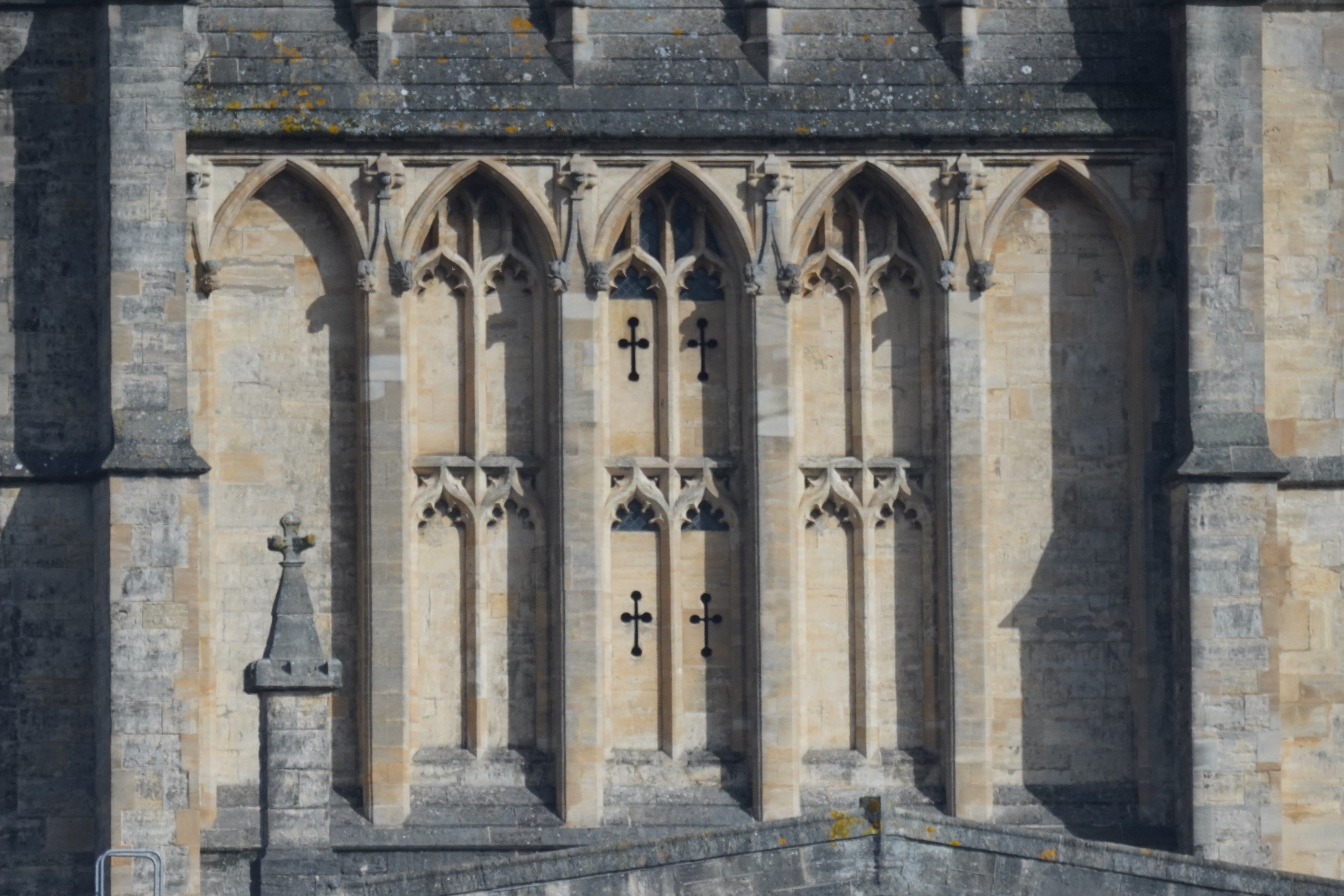Digital Camera World Verdict
Shooting at 900mm is a big ask even on a full-frame camera. This 900mm APS-C format lens gives an even more humungous ‘effective’ focal length of 1,350mm on Fujifilm X and Sony E bodies, rising further still to 1,440mm on Canon M system cameras, in its three mount options. Couple that with a narrow, fixed aperture of f/11 and the lack of both autofocus and optical stabilization, and the net result is that getting a passable shot demands a lot of effort, determination and perseverance. And even then, image quality is disappointing.
Pros
- +
Very compact for a 900mm lens
- +
Strong but lightweight build
- +
0.4x maximum magnification
Cons
- -
Fidgety manual focus
- -
No optical stabilization
- -
Lackluster image quality
Why you can trust Digital Camera World
The Tokina SZ 900mmPRO Reflex F11 MF CF serves a purpose, but we’re not entirely sure what that purpose is. Super-telephoto primes are generally the go-to choice for enthusiast and professional photographers who specialize in action, sports and wildlife photography, none of which are really within the remit of this lens. Instead, it’s more geared to shooters with Fujifilm X, Sony E or Canon M bodies, who want monster telephoto reach from a relatively compact, lightweight and inexpensive lens. But they’ll need the time and patience for fiddly manual focusing, and a rock-solid tripod.
The 900mm is actually the largest of three Tokina ‘PRO’ reflex/mirror lenses, with the most telephoto pulling power. Its smaller siblings are the SZ 300mmPRO Reflex F7.1 MF CF and the SZ 600mmPRO Reflex F8 MF CF.
Specifications
Mount: Canon EF-M, Fujifilm X, Sony E
Full-frame: No
Autofocus: No
Stabilisation: No
Lens construction: 7 elements in 7 groups
Angle of view: 1.8 degrees (1.7 degrees Canon)
Diaphragm blades: None
Minimum aperture: f/11
Minimum focusing distance: 2.61m
Maximum magnification ratio: 0.4x
Filter size: 86mm
Dimensions: 96.1x168mm
Weight: 725g
Key features
Literally holding up a mirror to subject matter, Tokina’s new ‘PRO’ reflex lenses follow a fairly archaic principle. As with other reflex lenses, it uses curved mirrors in conjunction with clear glass elements to bounce light backwards and forwards within the barrel. As such, light enters through a ring around the circumference of the lens at the front, is bounced back by a curved mirror at the rear, and then focused onto the camera’s image sensor by an additional mirror positioned front and center. The design always carries the risk that image quality will lose something in the translation along the way.
So why would a lens designer want to mess about with mirrors? The short answer is that by twice ‘folding’ the image in on itself, the size and weight of the complete lens can be dramatically reduced, along with the cost of manufacturing it. As such, this Tokina is relatively tiny and only a fraction of the weight and cost of most conventional super-telephoto lenses.
That said, the Canon RF 800mm f/11 IS STM is a regular lens with the same fixed aperture rating and weighs in at a modest 1,206g, less than double the Tokina’s 725g. And the Canon is full-frame compatible rather than being limited to APS-C crop sensor cameras, as well as sporting super-fast autofocus and highly effective optical image stabilization. It’s also reasonably compact for stowage, thanks to a retractable design.
As a fully manual lens, the Tokina has neither autofocus nor optical stabilization. Both of these can be deal-breakers if you’re after a super-tele lens for shooting anything other than static subjects. Given that the effective focal length on APS-C format Fujifilm X and Sony E is a monstrous 1,350mm (1,440mm for Canon M system cameras), you’ll need a shutter speed of around 1/1500th of a second and preferably more, for a decent hit rate in handheld shooting. And the only way to get that under anything other than really bright sunlight, is to boost your camera’s ISO setting to high levels, which can impact heavily on image quality. More on that later.
Build and handling
The lens feels robust and well-engineered, although as with the other two in Tokina’s range, it lacks weather-seals. It’s refreshingly small and lightweight for a super-telephoto lens but given the hit and mostly miss nature of handheld shooting with this lens, you’re likely to need to carry a sturdy tripod as well, which piles the bulk and weight back on again.
There’s no way of adjusting the aperture in a reflex lens, so you’re stuck with f/11, like it or not. The optical design makes for a very tight depth of field so ultra-precise focusing is a must, which can be tremendously difficult in practice. Despite having a long rotational travel, even the slightest movement of the focus ring can cause a large shift in the focus distance. Even when focusing on very distant objects, you can’t simply set focus at the infinity mark and forget about it, as the focus ring is something of a Buzz Lightyear in nature, going to infinity and beyond.
Performance
To get a decent hit rate with this lens, we completely gave up on handheld shooting. Tokina says the lens can benefit from a camera’s IBIS (In Body Image Stabilization). This shifts the image sensor to compensate for physical movements and vibration. However, the majority of Fujifilm and Sony APS-C format cameras don’t actually have IBIS, and it’s not featured on any of Canon’s M system cameras.
Regardless of this, we tried the lens on a Sony A7R III camera body. As the Tokina is a ‘dumb lens’ with no electronic communication, we set the appropriate APS-C crop mode manually and dialed in the right custom settings for in-body SteadyShot. Throughout our testing, we found that in-body stabilization made no difference whatsoever in minimizing camera shake. It’s not surprising, because sensor-shift stabilization is notoriously second-best even for modest telephoto focal lengths, which is why so many telephoto lenses designed for cameras with IBIS feature additional optical image stabilization.
Ultimately, we found that every shot we took demanded a lot of set-up time and fiddling around with the very finicky focus ring, and trying to guard against any vibration or movement in a sturdy Manfrotto 055 series 3-section carbon fiber tripod and chunky XPRO ball head. After reviewing the resulting images in magnified playback mode, we often found they needed retaking. Even the best results tended to be lacking in sharpness and clarity, with poor contrast, color rendition, and vibrancy.
The better news is that, like the Tokina 300mm and 600mm in the series, the 900mm produces very little color fringing and distortion. Vignetting is also negligible. One of the test shots below shows the typical ‘donut bokeh’ that reflex lenses create from defocused lights and bright spots. All of the other shots were taken in bright, direct sunlight but, apart from those with very contrasty areas of brightness and shadow, they look rather drab and lifeless, as if they were shot in overcast conditions.
Ultimately, using the Tokina 900mm can feel a bit of a chore. You need to put in a lot of manual effort, with relatively little reward.
Sample images

Lab results
We run a range of lab tests under controlled conditions, using the Imatest Master testing suite. Photos of test charts are taken across the range of apertures and zooms (where available), then analyzed for sharpness, distortion and chromatic aberrations.
We use Imatest SFR (spatial frequency response) charts and analysis software to plot lens resolution at the center of the image frame, corners and mid-point distances, across the range of aperture settings and, with zoom lenses, at four different focal lengths. The tests also measure distortion and color fringing (chromatic aberration).
Sharpness:
The best camera deals, reviews, product advice, and unmissable photography news, direct to your inbox!
We've included all three SZ PRO tele prime lenses on a single graph so you can easily compare the trio.
It's easy to see here the 900mm doesn't score well for sharpness, being disappointingly soft across the entire image frame. For reference, a Canon RF 800mm f/11 IS STM - a lens similar to the Tokina in terms of its accessible price, focal length and fixed f/11 aperture - scores 1991/1631/1350 for center/mid/corner sharpness.
Fringing:
Again, we've included all three SZ PRO tele prime lenses on a single graph so you can easily compare the trio.
If the SZ PRO 900mm has one redeeming feature, it's that it produces very little chromatic aberration, even into the corners of frame.
Distortion: 0.86
There's a little pincushion distortion, but its relatively minor given the lens' extreme telephoto focal length and is barely noticeable.
Verdict
Shooting at 900mm is a big ask even on a full-frame camera. This 900mm APS-C format lens gives an even more humungous ‘effective’ focal length of 1,350mm on Fujifilm X and Sony E bodies, rising further still to 1,440mm on Canon M system cameras, in its three mount options.
And then there's the narrow fixed aperture of f/11, the lack of optical stabilization and autofocus, and the frustratingly imprecise manual focusing. Combine all these factors and the net result is that getting a passable shot demands a lot of effort, determination, and perseverance. And even then, image quality is disappointing.
So who is the target buyer for this lens? If you want to shoot moving subjects - sports, wildlife - forget it. There's simply no way you could focus accurately enough or hold the lens steady enough. Likewise, handheld use is completely unfeasible, unless you're a stone statue. Lunar photography may be possible, but even then, the handling shortcomings would still be immensely frustrating.
Quite simply, the only redeeming feature of the Tokina SZ 900mmPRO Reflex F11 MF CF is its compact and light body, but when the lens is this impractical to use, this hardly matters.
Read more:
• Best camera lenses
• Best Canon lenses
• Best Nikon lenses
• Best Sony lenses
Matthew Richards is a photographer and journalist who has spent years using and reviewing all manner of photo gear. He is Digital Camera World's principal lens reviewer – and has tested more primes and zooms than most people have had hot dinners!
His expertise with equipment doesn’t end there, though. He is also an encyclopedia when it comes to all manner of cameras, camera holsters and bags, flashguns, tripods and heads, printers, papers and inks, and just about anything imaging-related.
In an earlier life he was a broadcast engineer at the BBC, as well as a former editor of PC Guide.












